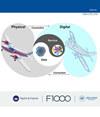启用数字孪生的技术标准综述
引用次数: 11
摘要
在开发数字孪生应用的过程中,由于缺乏对数字孪生术语、体系结构和模型相关标准的参考,导致用户对数字孪生的理解存在差异,难以实现不同企业或领域之间数据、模型和服务的互联互通。因此,数字孪生由于其在多个领域之间互操作性的本质,需要将标准化作为实现的试点工具。本文介绍了基于数字孪生五维模型的数字孪生技术的背景和概况,并介绍了数字孪生标准化的最新进展。我们进一步分析了数字孪生标准化面临的挑战,并提出了未来数字孪生标准化的建议。对数字孪生标准前景的分析整合了来自诸如国际标准化组织(ISO)、国际电工委员会(IEC)、国际电信联盟(ITU)和电气和电子工程师协会(IEEE)等管理机构的信息。本文章由计算机程序翻译,如有差异,请以英文原文为准。
A review of the technology standards for enabling digital twin
In the process of developing digital twin enabling applications, a lack of reference to standards related to digital twin terms, architecture and models leads to differences between users' understanding of digital twin, and it is difficult to realize the interconnection of data, models, and services between different enterprises or fields. Therefore, digital twin, by its nature of interoperability between multiple domains, requires standardization as a pilot tool for implementation. This paper provides the background and introduction of digital twin technology based on the digital twin five-dimension model, then refers to the latest developments of digital twin standardization. We further analyze the challenges and provide suggestions of future digital twin standardization. The analysis of the standards landscape for digital twin consolidates information from governing bodies such as the International Organization for Standardization (ISO), International Electrotechnical Commission (IEC), International Telecommunication Union (ITU), and Institute of Electrical and Electronics Engineers (IEEE)
求助全文
通过发布文献求助,成功后即可免费获取论文全文。
去求助
来源期刊

Digital Twin
digital twin technologies-
自引率
0.00%
发文量
0
期刊介绍:
Digital Twin is a rapid multidisciplinary open access publishing platform for state-of-the-art, basic, scientific and applied research on digital twin technologies. Digital Twin covers all areas related digital twin technologies, including broad fields such as smart manufacturing, civil and industrial engineering, healthcare, agriculture, and many others. The platform is open to submissions from researchers, practitioners and experts, and all articles will benefit from open peer review.
The aim of Digital Twin is to advance the state-of-the-art in digital twin research and encourage innovation by highlighting efficient, robust and sustainable multidisciplinary applications across a variety of fields. Challenges can be addressed using theoretical, methodological, and technological approaches.
The scope of Digital Twin includes, but is not limited to, the following areas:
● Digital twin concepts, architecture, and frameworks
● Digital twin theory and method
● Digital twin key technologies and tools
● Digital twin applications and case studies
● Digital twin implementation
● Digital twin services
● Digital twin security
● Digital twin standards
Digital twin also focuses on applications within and across broad sectors including:
● Smart manufacturing
● Aviation and aerospace
● Smart cities and construction
● Healthcare and medicine
● Robotics
● Shipping, vehicles and railways
● Industrial engineering and engineering management
● Agriculture
● Mining
● Power, energy and environment
Digital Twin features a range of article types including research articles, case studies, method articles, study protocols, software tools, systematic reviews, data notes, brief reports, and opinion articles.
 求助内容:
求助内容: 应助结果提醒方式:
应助结果提醒方式:


